Posted under Poland

As I pondered the thought of seeing Auschwitz, scenes from Schindler’s List and flashes of Holocaust photographs flashed through my mind, sending chills down my spine. Even after our seemingly comprehensive study of the Holocaust at Yad Vashem in Israel and other museums in Europe, I was haunted by the idea of walking among so many ghosts.
On our second day in Krakow, we stepped outside our warm hostel to a gray, bitter cold morning. The weather seemed strangely appropriate. During the hour-and-a-half drive to Auschwitz, I kept my nose buried in a book, mostly to distract from the sense of dread that loomed over me.
Our organized tour turned out to be quite disorganized and we ended up waiting in the lobby of the admission hall for about thirty minutes among flocks of other tour groups. It was very crowded, overcrowded in my opinion, and the groups became confusingly co-mingled. We each received a headset through which everyone in our 40+ person tour group could hear the guide’s commentary without his having to shout – a clever concept, though we would have preferred a much smaller group to begin with.
 The most noticeable demographic among the tour groups that day were Hebrew-speaking young adults who were draped in and waving Israeli flags. When asked where the majority of visitors come from, our guide answered “America, Britain, and Poland.” It struck me as odd that certain other European countries didn’t top that list.
The most noticeable demographic among the tour groups that day were Hebrew-speaking young adults who were draped in and waving Israeli flags. When asked where the majority of visitors come from, our guide answered “America, Britain, and Poland.” It struck me as odd that certain other European countries didn’t top that list.
Auschwitz was established by the Nazis in a vacant Polish army barracks in 1940. By the end of the war, two subsequent camps – Birkenau (Auschwitz II) and Monowitz (Auschwitz III) were fully operational as extermination and labor camps within a few kilometers of the original camp. When the Nazis fled, they destroyed much of Auschwitz though, in their haste, much of the area was left intact.
As we entered the grounds, I was immediately struck by the electrified barbed wire fences that seemed to be everywhere. If you removed the barbed wire and the guard towers, the prison barracks might have been compared to student housing at a small university. We passed by the wrought-iron entry gate bearing the words Arbeit Macht Frei, Work Will Set You Free. In fact, Auschwitz was originally established as a labor camp for Polish prisoners. Later, when it doubled as an extermination facility, only the strongest of the prisoners were selected to enter into forced labor; the others, mainly women, children, the sick, and the elderly, were immediately transferred to the gas chambers for extermination. Those who made the initial cut usually died within months from starvation, disease, exposure, or execution. One of the most chilling exhibits was a long hallway inside one of the buildings, its walls covered with rows of mug shots from Nazi files of people who perished at Auschwitz. The photos, only a small sample of the 1.5 million people killed at Auschwitz, had captions noting the inmate’s date of registration at the camp and date of death. Most died within three months of arrival. The faces looked sallow with the sad, bulging eyes of malnutrition. Most of the women’s heads had already been shaven.
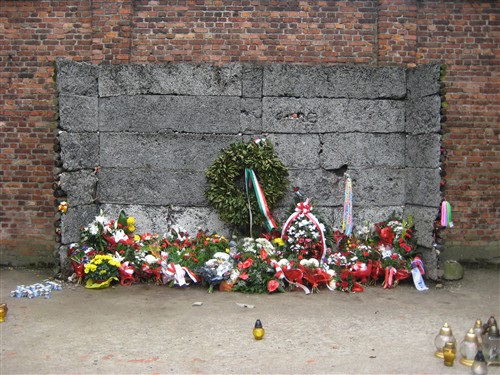 Inside one of the buildings were vast collections of clothes, shoes, spectacles, suitcases, crutches, canes, prosthetic limbs and literally TONS of human hair. The Nazis took everything. They transported the valuables to Germany by the train load. The human hair was used in the textile industry to fashion cloth, nets, and other fabrics. We know this because in their haste to depart, the Nazis left evidence behind. We saw the huge piles of hair and also some samples of cloth and netting that had been made from it.
Inside one of the buildings were vast collections of clothes, shoes, spectacles, suitcases, crutches, canes, prosthetic limbs and literally TONS of human hair. The Nazis took everything. They transported the valuables to Germany by the train load. The human hair was used in the textile industry to fashion cloth, nets, and other fabrics. We know this because in their haste to depart, the Nazis left evidence behind. We saw the huge piles of hair and also some samples of cloth and netting that had been made from it.
We walked through one building that had served as the punishment block. It was there that the method of mass murder by poisoned gas was first tested on a group of Polish prisoners. There was a starvation cell where prisoners were locked with no food or water until they starved to death. Another cell, which was about the size of a phone booth, was used to punish prisoners by forcing four people to stay in it during all hours outside their mandatory 11-hour work requirements. After toiling at forced labor, they would have to sleep standing up. This punishment usually led to a quick death from exhaustion.
Between two rows of residential blocks was a short gravel lane with an execution wall at the end of it. Before the gas chambers were implemented, prisoners were shot in front of the execution wall while terrified residents heard everything from their beds. The wall was adorned with flowers and memorial candles. Along the sides of the same lane, wooden posts stuck out of the ground. As punishment, prisoners had their hands tied behind their backs and were suspended from the ground, often causing dislocated shoulders and loss of consciousness from the pain.
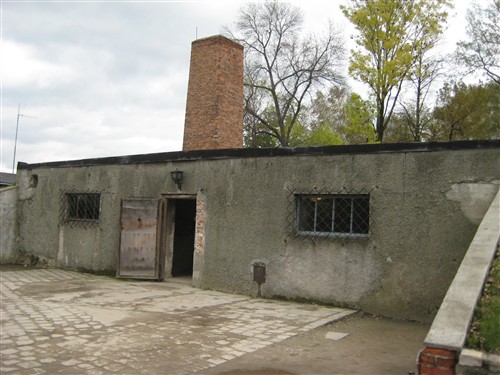
As we approached the gas chamber, I felt a sinking feeling in my stomach. The building was a low, dreary cement block with a single brick chimney. As our group gathered in the stone courtyard in front of the gas chamber, our guide explained that the prisoners were made to undress in the courtyard since there was no other place to do this. As he spoke, my mind filled with images of women, children, the elderly, and the sick having survived days long train rides in cramped rail cars, the women having “donated” their hair to the cause, now having to strip naked in a cold stone yard, exposed to the harsh Polish elements and the guards’ loathing stares. What further dignity could be robbed from them? What depravity still lay before them!
We filed into the gas chamber, its cold gray walls enveloping us completely. We looked to the ceiling and saw the small openings through which the Nazi doctors poured pellets of Zyklon B (a hydrogen-cyanide insecticide) onto the panicked prisoners. When the pellets reached 27 degrees Celsius, they began to dissolve into poisonous gas. It was a slow, painful death, the ones closest to the pellets dying first and those further from the poison being the last to perish. The Nazis were experts in efficiency. They knew the exact amount of the deadly chemical that was required to kill everyone inside the chamber. To cover the sounds of the screams, they parked trucks on the gravel road between the gas chamber and the main part of the camp and left the engines running. To facilitate the disposal of the corpses, the Nazis built an incinerator onto the gas chamber. Before that, bodies were burned in piles in the open air as evidenced by a clandestine photograph that survived the war. When the Allied forces arrived at Auschwitz, they found human ashes in the incinerator. The ashes were displayed with memorial candles constantly burning.
As Hitler’s plan to exterminate Jews from the human race materialized, the need arose for expansion of Auschwitz. Three kilometers away from the original camp, a Polish village was cleared out and the materials from the villagers’ homes and businesses were used to build Birkenau (a.k.a. Auschwitz II). “This vast (175 hectares), purpose-built and grimly efficient camp had more than 300 prison barracks and four huge gas chambers complete with crematoria. Each gas chamber held 2,000 people and electric lifts raised the bodies to the ovens. The camp could hold 200,000 inmates at one time.” (Lonely Planet: Eastern Europe, Feb 2007, p. 570)
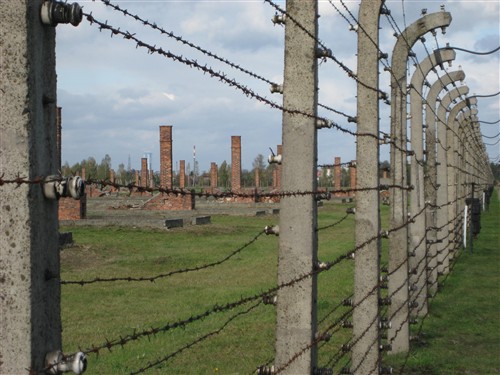
It was at Birkenau that the extermination of the greatest numbers of people took place. Though much of the camp was destroyed by the Nazis and other buildings were dismantled so that the displaced villagers could rebuild their homes, the remnants provide a shocking view of the scale of this horrific operation. Walking through one of the residential barracks at Birkenau, we saw rooms of three-level wooden bunk beds. Each platform, about the size of a queen-size bed, slept as many as five adults. The buildings themselves were simply constructed and lacked any insulation against the harsh Polish winters.
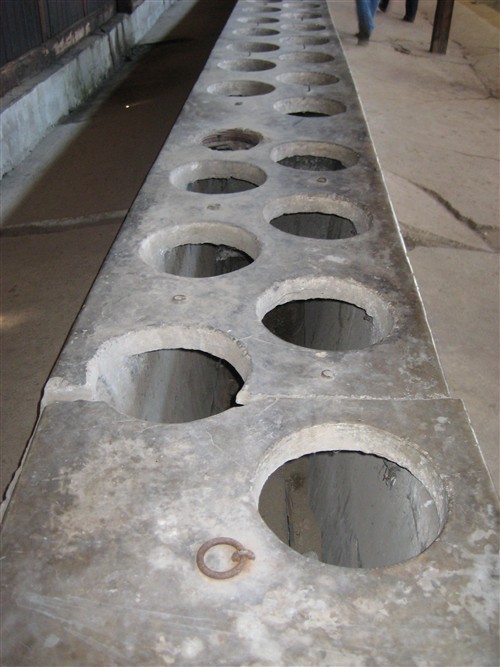 The latrine building was an eye-opener that came with yet another sad story. Inside the rectangular structure, a long trench had been dug down the center. A single long piece of white construction material, with holes cut into it, was laid across low cement blocks on either side of the trench. These were the toilets. According to our guide, every aspect of the prisoners’ existence was strictly controlled by the guards, including their use of the toilet. Prisoners were allowed to use the toilet only twice per day: once in the morning and then once in the evening, after their eleven-hour work shift. There was only a short window of time allowed for the toilet use and the long rows of holes were insufficient for the number of prisoners who needed to use them. Often prisoners would miss one of the two toilet opportunities. Use of toilet without permission was cause for punishment. Sadly, this regimen was actually an improvement over the conditions in the early years of the camp’s existence where prisoners were prohibited from using water to wash themselves.
The latrine building was an eye-opener that came with yet another sad story. Inside the rectangular structure, a long trench had been dug down the center. A single long piece of white construction material, with holes cut into it, was laid across low cement blocks on either side of the trench. These were the toilets. According to our guide, every aspect of the prisoners’ existence was strictly controlled by the guards, including their use of the toilet. Prisoners were allowed to use the toilet only twice per day: once in the morning and then once in the evening, after their eleven-hour work shift. There was only a short window of time allowed for the toilet use and the long rows of holes were insufficient for the number of prisoners who needed to use them. Often prisoners would miss one of the two toilet opportunities. Use of toilet without permission was cause for punishment. Sadly, this regimen was actually an improvement over the conditions in the early years of the camp’s existence where prisoners were prohibited from using water to wash themselves.
Our final moments in Auschwitz-Birkenau were spent at the top of the main guard tower, overlooking the entire expanse of the most infamous genocide factory in history. The buildings that remained intact provided a glimpse of daily life for many of the 1.5 million human beings who met a tragic end at the hands of the Nazis. Behind the barracks stood a graveyard of chimneys, the only remains of hundreds of barracks that were dismantled or destroyed, standing like monuments to victims of the Holocaust.
Seeing Auschwitz was a very different experience from visiting a Holocaust Museum. Absent were the gruesome photos of naked, skeletal bodies and victims of the infamous Dr. Mengele’s anatomical experiments. Absent were the articles of propaganda that attempt to explain how a nation came to revere a madman. Absent were bios on Hitler’s henchmen. Absent were personal accounts from the survivors.
Auschwitz stands on its own merit as a manifestation of sickening, rigid efficiency. The extermination of what Hitler perceived as a physically and intellectually inferior race, was conducted in a businesslike fashion whereby the Nazis took every imaginable value from the prisoners – property, clothing, hair, labor – before executing en masse in a frighteningly methodical manner.
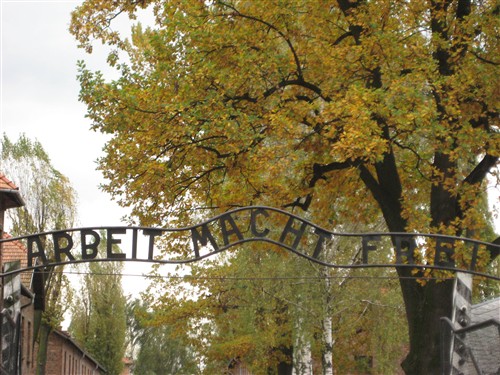
Reflecting on all that I have learned about the Holocaust, I find myself clinging to my faith in a merciful God. I pray that the souls of the millions of victims have found a place of peace. I want my world to become a better place; a place where God’s will is done “on Earth as it is in Heaven”. Reading world news today does not help to restore my faith in man. Some days I can’t help but to think that the bearded man in the clouds is sitting up there with one hand on the faucet, ready to send down the next flood.

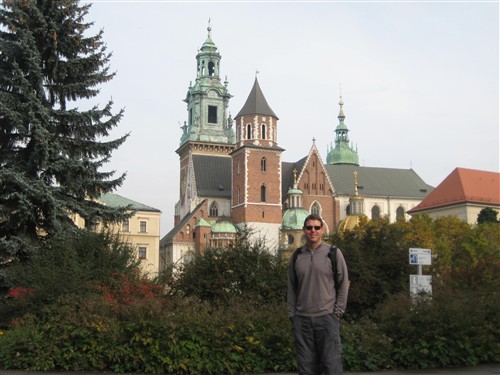 The most remarkable feature of the cathedral was its bell tower which contained the country’s largest bell, made from the melted metal weapons of defeated foreign armies, and weighing in at 11 tons. We climbed the steep wooden staircase to the top of the tower and were rewarded with superb views of the city.
The most remarkable feature of the cathedral was its bell tower which contained the country’s largest bell, made from the melted metal weapons of defeated foreign armies, and weighing in at 11 tons. We climbed the steep wooden staircase to the top of the tower and were rewarded with superb views of the city. We happened upon a grand celebration during our visit to Krakow – the 30th anniversary of the inauguration of Pope John Paul II. The late pope was Krakow’s most beloved son and his memory is honored throughout the city with banners, statues, and various other monuments. The celebration took place just outside the Franciscan Church – known for its Art Nouveau stained-glass windows. We had heard symphony music from down the block and followed our ears to the church, where a symphony orchestra, complete with vocalists, was entertaining a gathering crowd. Outside the church hung banners of the pope; a big-screen TV played a video medley of his public appearances; and a ledge along the sidewalk was covered with colorful memorial candles. It was a lovely tribute – the reverence of the people shone in their faces. And the stained-glass windows inside the Franciscan Church were magnificent!
We happened upon a grand celebration during our visit to Krakow – the 30th anniversary of the inauguration of Pope John Paul II. The late pope was Krakow’s most beloved son and his memory is honored throughout the city with banners, statues, and various other monuments. The celebration took place just outside the Franciscan Church – known for its Art Nouveau stained-glass windows. We had heard symphony music from down the block and followed our ears to the church, where a symphony orchestra, complete with vocalists, was entertaining a gathering crowd. Outside the church hung banners of the pope; a big-screen TV played a video medley of his public appearances; and a ledge along the sidewalk was covered with colorful memorial candles. It was a lovely tribute – the reverence of the people shone in their faces. And the stained-glass windows inside the Franciscan Church were magnificent!